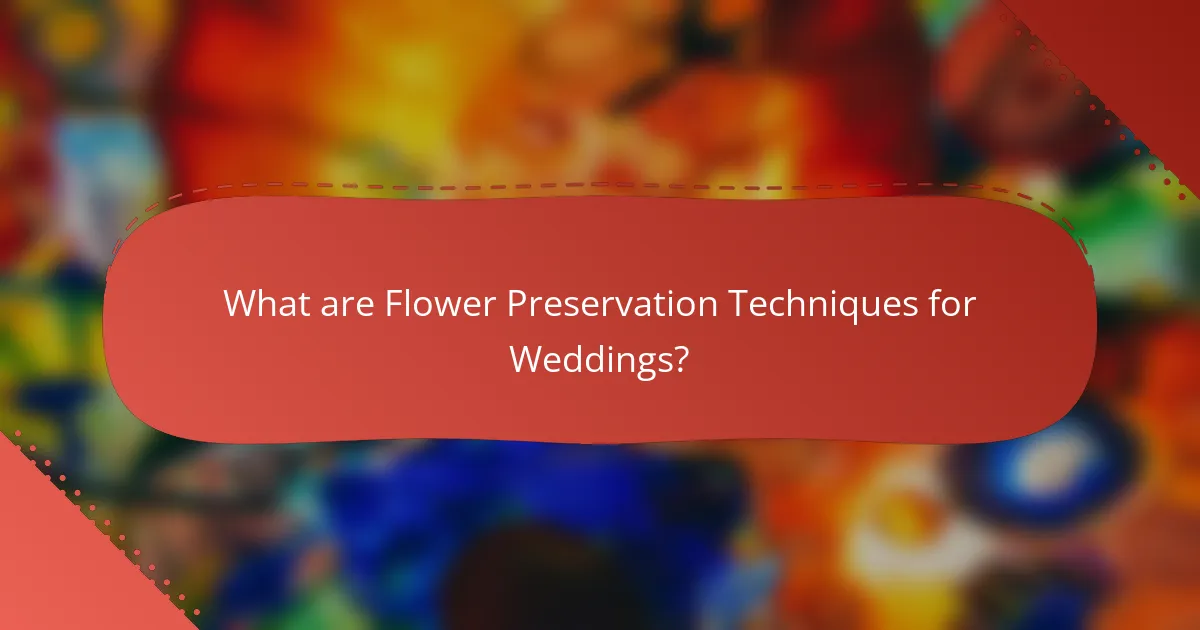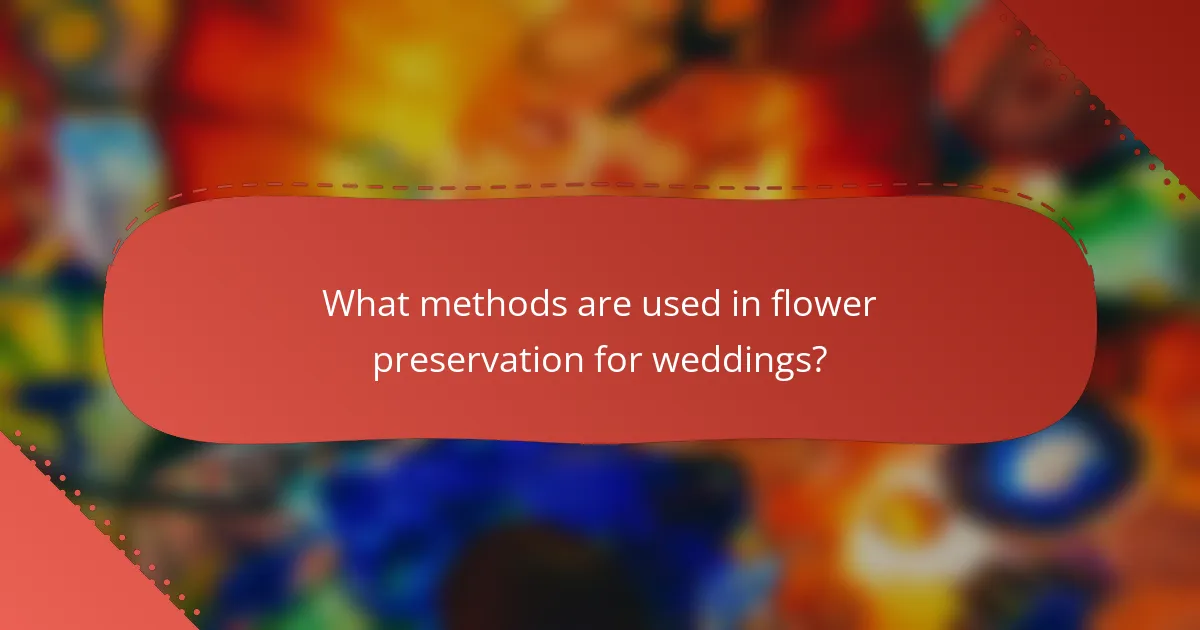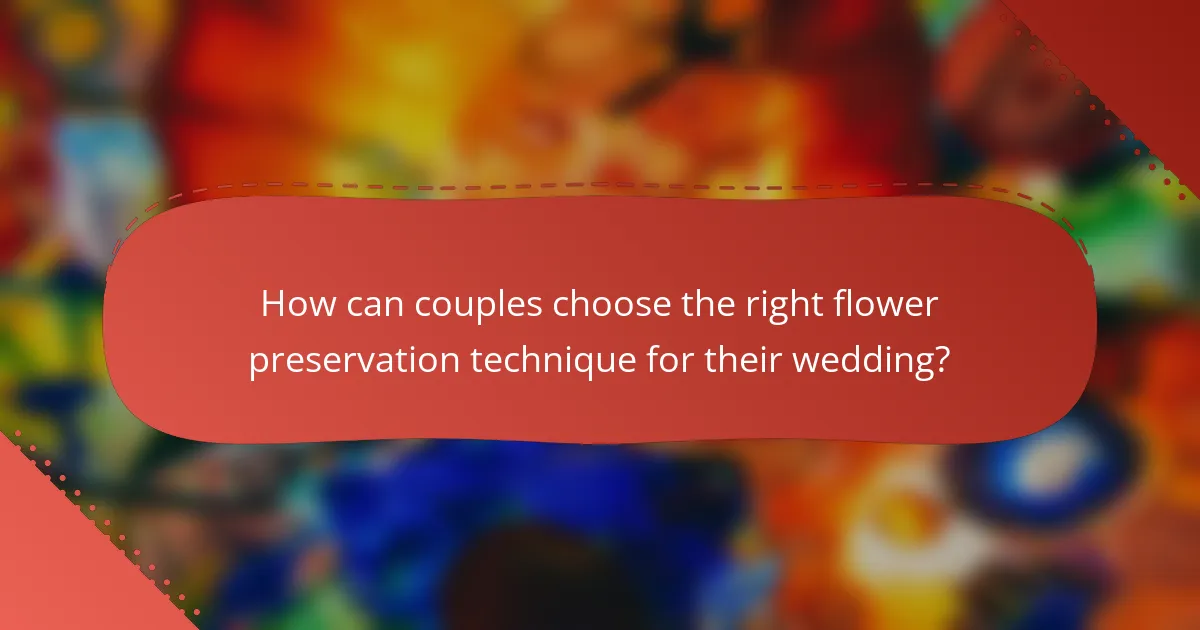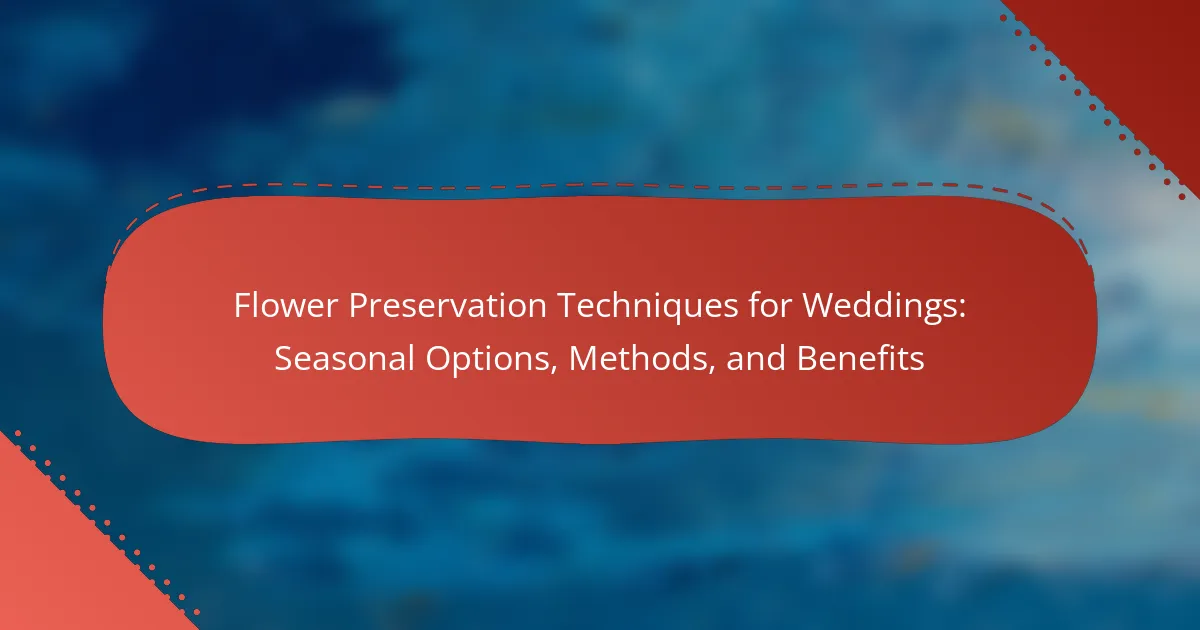
What are Flower Preservation Techniques for Weddings?
Flower preservation techniques for weddings include drying, pressing, and using silica gel. Drying involves hanging flowers upside down in a dark, dry place. This method retains color and shape over time. Pressing involves flattening flowers between heavy books or in a flower press. This technique creates a two-dimensional display. Silica gel absorbs moisture from flowers, preserving their natural shape and color. This method is often used for delicate blooms. Other techniques include resin preservation, where flowers are encased in resin for a lasting keepsake. These methods ensure that wedding flowers can be cherished long after the event.
How do flower preservation techniques enhance wedding experiences?
Flower preservation techniques enhance wedding experiences by allowing couples to retain the beauty of their floral arrangements long after the event. These techniques include drying, pressing, and resin encapsulation, which help maintain the original colors and shapes of the flowers. Preserved flowers serve as lasting mementos that evoke memories of the special day. Research indicates that couples often cherish preserved flowers, as they symbolize love and commitment. Additionally, preserved flowers can be incorporated into home decor, providing a continuous reminder of the wedding. This emotional connection adds value to the overall wedding experience.
What types of flowers are commonly preserved for weddings?
Roses, peonies, and lavender are commonly preserved for weddings. Roses are favored for their classic beauty and symbolism of love. Peonies are popular for their lush appearance and fragrance. Lavender is chosen for its calming scent and rustic charm. Other flowers include hydrangeas, which maintain their shape and color well. Baby’s breath is often used for a delicate touch. Dried flowers can also be used, offering a vintage aesthetic. These options ensure lasting memories of the wedding day.
Why is flower preservation important for wedding memories?
Flower preservation is important for wedding memories because it allows couples to retain the beauty of their floral arrangements long after the event. Preserved flowers serve as tangible reminders of the wedding day. They capture the emotions and aesthetics of the ceremony and reception. Additionally, preserved flowers can be displayed in various forms, such as shadow boxes or framed art. This makes them a lasting keepsake that can evoke memories for years to come. Research shows that visual triggers, like preserved flowers, can enhance memory recall associated with significant events. Thus, flower preservation plays a vital role in maintaining the emotional connection to wedding memories.
What seasonal options are available for flower preservation?
Seasonal options for flower preservation include drying, pressing, and using silica gel. In spring, flowers like tulips and daffodils are ideal for drying. Summer offers vibrant blooms such as roses and sunflowers, which can be pressed for keepsakes. Autumn provides foliage like maple leaves, suitable for both pressing and drying. Winter flowers, such as evergreens, can be preserved in water or through freezing methods. Each method effectively retains the beauty of seasonal flowers, ensuring lasting memories from weddings.
How do seasonal flowers affect preservation choices?
Seasonal flowers significantly influence preservation choices due to their availability and freshness. When flowers are in season, they are more vibrant and have a longer lifespan. This freshness enhances the effectiveness of preservation methods such as pressing, drying, or using silica gel. For instance, summer flowers like peonies or dahlias retain their color better when preserved immediately after being cut. Conversely, out-of-season flowers may wilt quickly, leading to less successful preservation outcomes. Studies show that flowers preserved at their peak freshness maintain aesthetic quality for longer durations. Therefore, selecting seasonal flowers optimizes preservation techniques and results in more visually appealing outcomes.
What are the best flowers to preserve in each season?
The best flowers to preserve in each season are as follows:
In spring, consider preserving peonies and lilacs. These flowers have vibrant colors and strong scents. They are abundant during this season.
In summer, roses and sunflowers are ideal for preservation. Roses maintain their beauty and fragrance well. Sunflowers add a cheerful touch and dry nicely.
In autumn, consider preserving chrysanthemums and dahlias. These flowers have rich colors that enhance fall arrangements. They hold up well during the drying process.
In winter, evergreen branches and dried hydrangeas are excellent choices. Evergreens provide a seasonal touch. Dried hydrangeas maintain their shape and color effectively.

What methods are used in flower preservation for weddings?
Common methods used in flower preservation for weddings include air drying, pressing, and silica gel drying. Air drying involves hanging flowers upside down in a dark, dry place. This method retains color and shape effectively. Pressing flowers involves placing them between heavy books or in a flower press. This method creates flat, decorative pieces. Silica gel drying uses silica gel crystals to absorb moisture from flowers. It preserves flowers in their original shape and color. Each method has its own benefits, catering to different aesthetic preferences and preservation goals.
How does drying compare to other preservation methods?
Drying preserves flowers by removing moisture, preventing decay. Compared to other methods like freezing or using silica gel, drying is simpler and requires less equipment. It retains the flower’s shape and color effectively. Research indicates that air-dried flowers maintain their aesthetic appeal longer than those preserved in liquid solutions. Drying is also cost-effective, as it often requires only air and time. Unlike chemical preservation, drying avoids the use of potentially harmful substances. Overall, drying is a practical and efficient preservation method for flowers.
What are the steps involved in air drying flowers?
To air dry flowers, start by selecting fresh, healthy blooms. Remove any leaves that will not be used in the arrangement. Gather the flowers into small bunches and secure them with rubber bands or string. Hang the bunches upside down in a dark, dry, and well-ventilated area. Ensure there is enough space between the bunches for air circulation. Leave the flowers to dry for about two to three weeks. Check for dryness by gently squeezing the petals. Once fully dried, store the flowers in a cool, dry place to preserve their quality.
What are the pros and cons of using silica gel for preservation?
Silica gel is effective for preserving flowers by absorbing moisture. The pros include its ability to maintain color and shape, leading to aesthetically pleasing results. Silica gel is reusable and can be easily stored. It is also non-toxic and safe for various uses. However, the cons involve the potential for flowers to become brittle. The process can be time-consuming and requires careful handling. Additionally, silica gel may not be suitable for all flower types, limiting its versatility.
What are the benefits of using specific preservation methods?
Specific preservation methods for flowers offer several benefits. They extend the lifespan of floral arrangements. This allows couples to cherish their wedding flowers for a longer period. Preservation methods, such as drying or pressing, maintain the flowers’ color and shape. This visual appeal contributes to lasting memories of the wedding day.
Additionally, preserved flowers can be used in various keepsakes. Examples include shadow boxes or framed displays. These items serve as beautiful home decor while reminding couples of their special day. Studies show that properly preserved flowers can last years, ensuring sentimental value over time.
Overall, specific preservation methods enhance the beauty and longevity of wedding flowers. They provide couples with tangible memories that can be appreciated for years to come.
How do different methods impact the longevity of preserved flowers?
Different methods significantly impact the longevity of preserved flowers. Common techniques include air drying, silica gel drying, and glycerin preservation. Air drying can lead to color fading and brittleness over time. Silica gel drying retains color and shape better but requires careful handling. Glycerin preservation maintains flexibility and moisture but can alter the flower’s appearance. Studies show that glycerin-treated flowers can last several years, while air-dried flowers may last only a few months. Therefore, the choice of preservation method directly affects how long the flowers remain visually appealing and structurally intact.
What aesthetic advantages do preserved flowers provide for wedding decor?
Preserved flowers offer several aesthetic advantages for wedding decor. They maintain their vibrant colors and intricate shapes for long periods. This longevity allows couples to enjoy beautiful arrangements throughout their wedding day. Preserved flowers can be arranged in various styles, from classic bouquets to modern centerpieces. Their versatility enables customization to match wedding themes and color palettes. Additionally, preserved flowers are often more affordable than fresh blooms over time. They also require no water or special care, making them easy to incorporate into decor. Overall, preserved flowers enhance the visual appeal of wedding settings while providing practical benefits.

How can couples choose the right flower preservation technique for their wedding?
Couples can choose the right flower preservation technique by considering their preferences and the type of flowers used. Various techniques include air drying, pressing, and resin preservation. Air drying is suitable for sturdy flowers like roses and lavender. Pressing works well for flat blooms like daisies and pansies. Resin preservation captures the flowers in a clear medium, offering a modern look. Couples should also consider the longevity and display options of each method. Additionally, researching local professionals can provide insights into the best techniques for specific flowers. Ultimately, the choice should reflect the couple’s style and the significance of the flowers.
What factors should be considered when selecting a preservation method?
When selecting a preservation method for flowers, consider the type of flowers being preserved. Different flowers have varying moisture levels and structural integrity. Evaluate the desired longevity of the preserved flowers. Some methods provide longer-lasting results than others. Assess the aesthetic outcome you wish to achieve. Certain techniques maintain color and shape better than others. Consider the available budget for preservation. Costs can vary significantly between methods. Review the space and conditions for storage. Some methods require specific environments to be effective. Lastly, think about the purpose of preservation. This can influence the choice of method significantly.
How do budget and personal style influence preservation choices?
Budget and personal style significantly influence flower preservation choices for weddings. A limited budget may restrict options to more affordable preservation methods like air drying or pressing. These methods are cost-effective and require minimal materials. Conversely, a higher budget allows for advanced techniques such as resin encapsulation or freeze-drying. These methods preserve flowers in their original state and offer a luxurious presentation.
Personal style shapes the choice of flowers and preservation techniques. Couples with a vintage aesthetic may prefer pressed flowers in a framed display. Modern couples might opt for sleek resin preservation to match contemporary decor. The style of the wedding influences the overall theme, which in turn affects preservation decisions. Ultimately, budget constraints and personal taste guide couples in selecting the most suitable preservation methods for their floral arrangements.
What are some best practices for preserving wedding flowers?
To preserve wedding flowers effectively, use drying, pressing, or freezing techniques. Drying involves hanging flowers upside down in a dark, dry place. This method retains color and shape. Pressing flowers between heavy books can create flat, decorative pieces. Freezing flowers in airtight containers helps maintain their original appearance. Additionally, using silica gel can absorb moisture and prevent decay. These methods can extend the beauty of wedding flowers for years. Proper preservation techniques can retain up to 90% of a flower’s original color and shape.
How can couples ensure the best results in flower preservation?
Couples can ensure the best results in flower preservation by selecting the right preservation method. Common methods include air drying, pressing, and using silica gel. Each method has specific requirements for optimal results. For air drying, flowers should be hung upside down in a dark, dry place. This prevents discoloration and maintains shape. Pressing requires placing flowers between heavy books or a flower press. This method is ideal for flat display. Silica gel absorbs moisture quickly, preserving color and shape effectively. Couples should also choose fresh flowers at their peak. The fresher the flowers, the better the preservation outcome. Additionally, couples can consult professionals for advanced techniques. Professional services often use vacuum sealing or freeze drying for superior results.
Flower preservation techniques for weddings encompass methods such as drying, pressing, and silica gel, which help maintain the beauty of floral arrangements long after the event. Commonly preserved flowers include roses, peonies, and lavender, with seasonal options influencing preservation choices. The article details the significance of flower preservation for wedding memories, discussing the aesthetic advantages and best practices for achieving optimal results. It further explores how budget and personal style impact preservation decisions, ensuring couples can select the most suitable techniques for their floral keepsakes.
